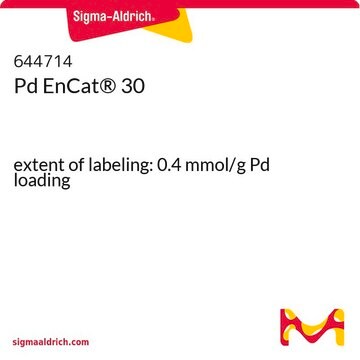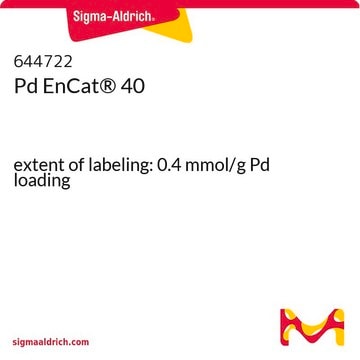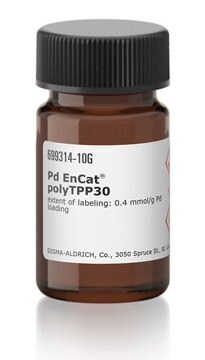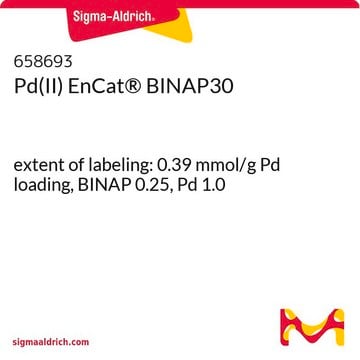644706
Pd EnCat® TPP30
extent of labeling: 0.4 mmol/g Pd loading, TPP 0.8, Pd 1.0
Synonim(y):
Palladium acetate and triphenylphosphine, microencapsulated in polyurea matrix
About This Item
Polecane produkty
zawiera
0.26-0.35 mmol/g phosphorous
0.37-0.44 mmol/g palladium
skład
Pd, 1.0
TPP, 0.8
przydatność reakcji
core: palladium
reaction type: Buchwald-Hartwig Cross Coupling Reaction
reaction type: Heck Reaction
reaction type: Hiyama Coupling
reaction type: Negishi Coupling
reaction type: Sonogashira Coupling
reaction type: Stille Coupling
reaction type: Suzuki-Miyaura Coupling
reagent type: catalyst
zakres etykietowania
0.4 mmol/g Pd loading
Opis ogólny
Zastosowanie
- Aryl iodides and bromides with terminal alkynes to form the corresponding coupling products under copper-free conditions.
- Bromobenzotriazoles and arylacetylenes in the presence of 1,5-diazabicyclo[5.4.0]undecene-5-ene (DBU) and copper iodide to form 2H-benzo[d][1,2,3]triazole derivatives.
Cechy i korzyści
- low residual metal levels in crude product
- easy recovery of catalyst
- compatibility of immobilized metal with various ligands to effect C-C bond forming reactions
- safer and easier to handle than Pd/C for hydrogenation
- efficiency and economy gains through recovery and recycling
Inne uwagi
Informacje prawne
Hasło ostrzegawcze
Warning
Zwroty wskazujące rodzaj zagrożenia
Zwroty wskazujące środki ostrożności
Klasyfikacja zagrożeń
Aquatic Chronic 3 - Carc. 2 - Flam. Sol. 2 - Repr. 2 - STOT RE 2 Oral
Organy docelowe
Liver,Kidney
Kod klasy składowania
4.1B - Flammable solid hazardous materials
Klasa zagrożenia wodnego (WGK)
WGK 3
Temperatura zapłonu (°F)
-9.4 - -7.6 °F
Temperatura zapłonu (°C)
-23 - -22 °C
Środki ochrony indywidualnej
dust mask type N95 (US), Eyeshields, Gloves
Certyfikaty analizy (CoA)
Poszukaj Certyfikaty analizy (CoA), wpisując numer partii/serii produktów. Numery serii i partii można znaleźć na etykiecie produktu po słowach „seria” lub „partia”.
Masz już ten produkt?
Dokumenty związane z niedawno zakupionymi produktami zostały zamieszczone w Bibliotece dokumentów.
Powiązane treści
Homogeneous palladium catalysts are widely utilized due to their versatility, reactivity and functional group tolerance.
Nasz zespół naukowców ma doświadczenie we wszystkich obszarach badań, w tym w naukach przyrodniczych, materiałoznawstwie, syntezie chemicznej, chromatografii, analityce i wielu innych dziedzinach.
Skontaktuj się z zespołem ds. pomocy technicznej










